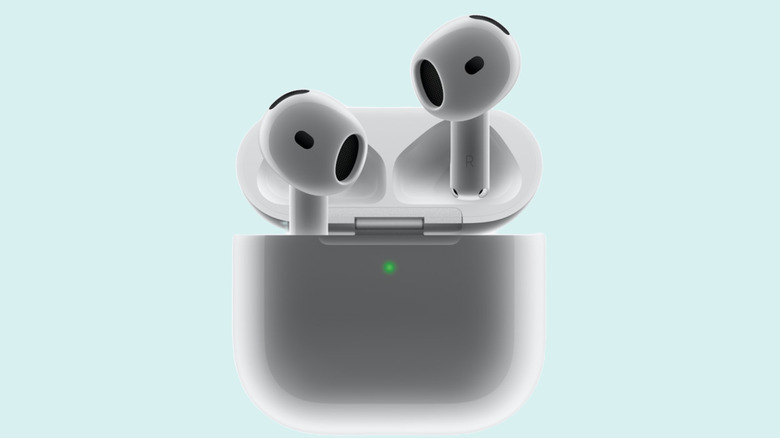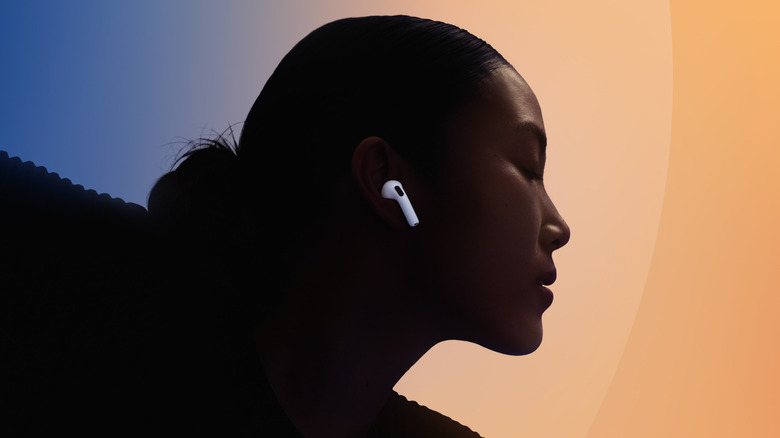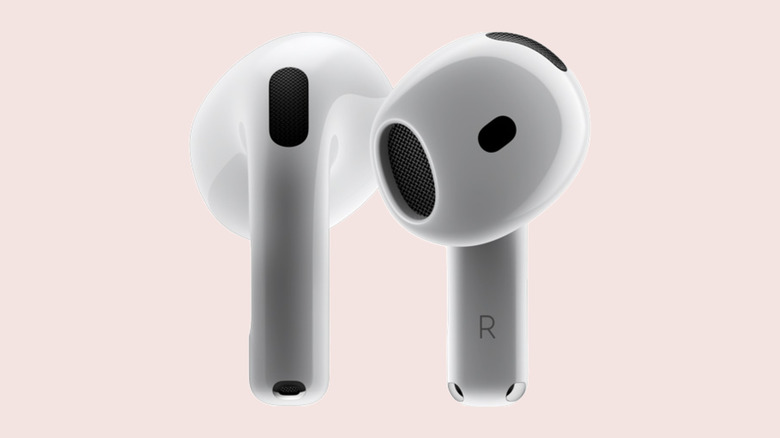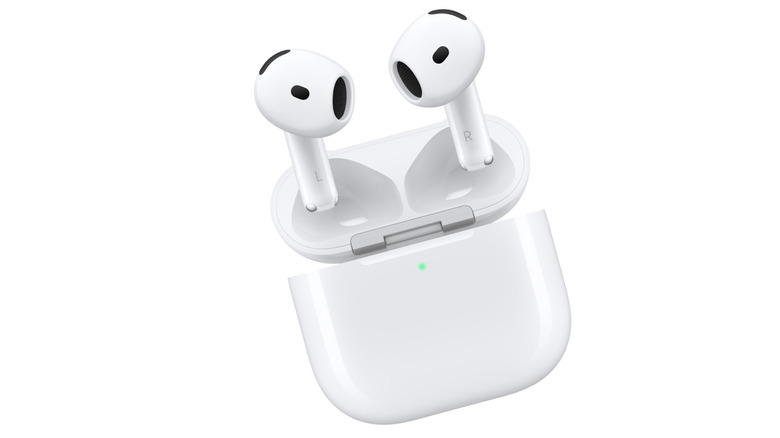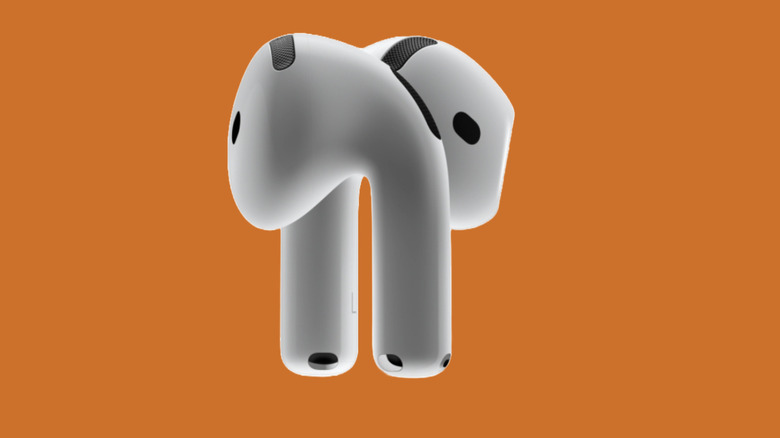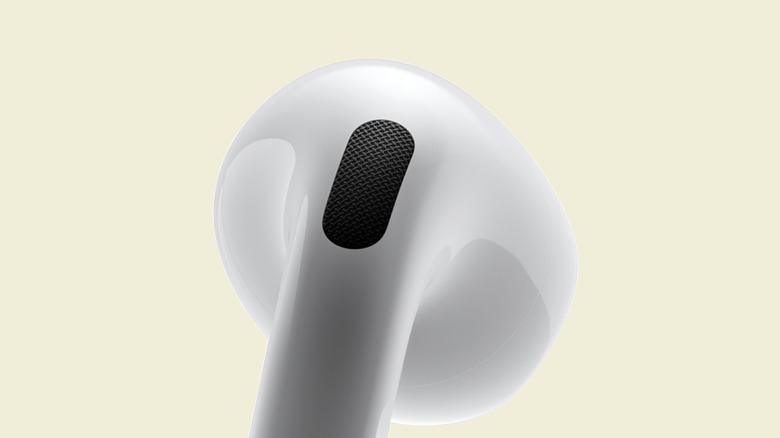7 Of The Most Exciting New AirPods 4 Features
Apple's Fall hardware launch event didn't really wow any standout hardware innovation. Yet, the biggest surprise was somehow Apple's audio portfolio, specifically, the entry-level AirPods 4. This time around, Apple put two versions of the entry-point AirPods on the table, putting perks like Active Noise Cancellation and Transparency Mode on the pricier version. So far, these features have been exclusive to the AiPods Pro and the over-the-ear AirPods Max headphones.
Apple also changed the design but still retained the open-ear look, unlike the sealed format on the AirPods Pro, which relies on ear tips to offer the best listening experience. The mic array has also been revised, matching that of the Pro models. Apple has also upgraded the chip inside, and this time, buyers are in for the next-gen firepower offered by the H2 chip. The Bluetooth connectivity has received a facelift, too, and Siri interactions have also made their way. If you're in two minds about the whole improvement aspect, the following are the biggest changes that might sway your opinion in favor of the AirPods 4.
ANC and Transparency mode
Active noise cancellation is essentially taking in external noise and creating an anti-sound wave to suppress the environmental sounds. As a result, external audio interferences don't enter your ears, and all you hear is the sound produced by the driver units inside the AirPods. The whole system works like a ripple in the pound, but in this case, we are dealing with the rarefactions and compressions in the sound waves that are reaching the AirPods.
Then you have transparency mode, which lets you hear the sounds around you without having to take your earbuds out. Instead of canceling the noise signals collected by the mics in ANC mode, the sound is simply allowed to tunnel inside after a bit of processing when you enable transparency mode on the AirPods 4. It's important to note that while the AirPods offer features like ANC and Transparency Mode, they are not intended to replace professional hearing aids or serve as adequate protection in high-noise environments like concerts.
As far as performance goes, Apple's implementation of noise cancellation and ambient audio passthrough is one of the best in the industry. And if the AirPods Pro 2 is anything to go by, the AirPods 4 (ANC trim) will leave buyers quite happy with finally getting a premium convenience at a not-so-premium asking price. Just keep in mind that an open-ear design doesn't quite offer the same kind of acoustic seal as the AirPods Pro, so there's a chance that some noise leakage might be observed with the AirPods 4.
Conversation Awareness
One of the most notable "intelligence" features on the AirPods Pro has been Conversation Awareness. As the name suggests, it lets you have conversations without having to take off the AirPods or worry about acoustic hindrance. When you begin speaking, the AirPods 4 will intelligently identify your voice, automatically lowering the volume of your audio content playing and ambient noise while enhancing the clarity of voices directly in front of you. This trick can make conversing in noisy settings easier with your AirPods in than without them. Once the conversation concludes, your AirPods will gradually restore the original audio levels.
Now, the whole premise of conversation awareness seems to be overlapping with what transparency mode does. Notably, the former is slightly different from engaging the regular transparency mode since it lets through all ambient noise. With Conversation Awareness, Apple focuses on certain voice frequencies (the speaker you are engaged in a conversation with) and tries to reduce other distractions. There's also more directionality to it since the voices in front of you are where the enhancement is focused.
The feature can be enabled from the pre-installed Settings app on an iPhone using a dedicated feature toggle. Notably, it can also be activated from the Control Center, by long pressing the volume bar. Conversation mode will be available when paired with devices running iOS 18 and macOS Sequoia running the latest firmware.
Wireless charging
The charging situation on Apple hardware has never been straightforward, and it was quite unpleasant in quite a pricey fashion. For example, the third-generation AirPods still clung to the Lightning standard, while their updated version only added MagSafe charging support without truly embracing the industry-standard Qi wireless charging standard. On the AirPods 4, Apple has sorted out the wired and wireless charging mess for its entry-level true wireless earbuds: The lower-end version of the AirPods 4 ditch the Lightning port in favor of a USB Type-C inlet.
On the version with ANC function, Apple has kept the doors open for both MagSafe and Qi-certified chargers. That means you can top up the battery inside using the Apple Watch charger or any MagSafe-certified charging puck. Most importantly, users can simply place the AirPods 4 (with ANC) on any Qi-capable wireless charging pad to juice up the battery without having to worry about the presence of magnetically locked power transfer hardware inside. In a nutshell, you don't have to spend a dime extra on charging gear for the fourth-generation AirPods.
The USB-C cable and adapter combo that charges your phone is good enough for the AirPods 4, and so is the case with any Qi wireless charging stand or pad on your desk. For the sake of bragging rights, Apple also claims that the AirPods 4's charging case is "the smallest in the industry with wireless charging capabilities."
Find My with speaker convenience
I have lost count of the misplaced accessories I have lost over the years, especially earbuds. It's a disheartening situation, but over the years, Apple's Find My network has helped me recover a lost iPhone and an Apple Watch on two occasions, but the AirPods 2 I left in a cab were lost forever. Fortunately, Apple is now bringing location tracking convenience to its entry-level earbuds after keeping the feature exclusive to the pricier Pro and Max models. But before you get too excited, there's a crucial distinction to be made here.
Only the AirPods 4 model with ANC (and a higher price to go with it) offer the Find My convenience. So, the next time you forget your AirPods, you can launch the Find My app on your iPhone and look them up via the web dashboard or a family member's device. Do keep in mind that, unlike misplaced iPhones, AirPods only relay the last known location on the Find My map.
But there's a little something for added convenience. Let's say you landed at the spot where the misplaced AirPods 4 were last located. Thankfully, it's not going to be a wild goose chase. That's because Apple has also fitted a speaker inside the charging case. So, when you're nearby, the charging case will play a beeping sound to help you look in the right direction.
Adaptive Audio
AirPods 4 still need to be manually enabled every time the acoustic situation changes around. You may have to toggle ANC for pristine music listening, and the next moment, you might have to enable transparency to hear the conversation around you. Adaptive audio solves that activation and tuning hassle. Apple defines it as a listening mode that dynamically merges Transparency mode and Active Noise Cancellation, adapting to the user's environment in real time for a more intelligent listening experience.
The company promises seamless adjustment of noise control as users transition between various settings and interactions throughout their day. Now, Adaptive Audio is not a standalone feature. Instead, it's a bundle of capabilities. One of them is a hybrid approach to ANC and transparency. Then there's Personalized Volume, which further enhances the listening experience by employing machine learning to make sense of environmental conditions and automatically refine the audio output. And finally, we have conversation awareness, which has been described above.
Apple says the whole system relies on machine learning to not only make audio adjustments but also learn over time to refine the listening experience. However, the company also warns that debris accumulation and earwax build-up could deteriorate Adaptive Audio performance, so you might want to clean the AirPods 4 from time to time.
More resilient against the elements
The third-generation AirPods only offered IPX4 level protection, which means they were only "sweat and water resistant for non-water sports and exercise." The fourth-generation AirPods also add protection against dust exposure into the mix, taking up the ingress protection rating to the IP54 tier. Or, if you need the technical details, they come with a "rating of IP54 under IEC standard 60529."
Now, there's often a bunch of confusion about the exact levels of assurance one can get after seeing these numbers. If you aren't aware, the first number in the IPXX format is about solid foreign objects, while the second number covers the water exposure aspect. In the case of the AirPods 4, we are at level 5 protection against solid particles, which, by the International Electrotechnical Commission's definitions, covers objects that are 2.5mm in size or larger. Therefore, they are classified as dust-protected (level 5) but not dust-tight (level 6).
The water resistance is at level 4. Based on lab tests and validation, it covers splashing water with "no harmful effects," but users should avoid submerging AirPods in water or exposing them to prolonged or high-pressure exposure, such as water jets.
Pressure vents
The design change on the AirPods 4 also comes with another crucial upgrade — a vent system for pressure equalization — though it is limited to the more expensive model with ANC onboard. This vent might look like an aesthetic touch, but it plays a key role in controlling the movement of air reaching the acoustic chamber. The acoustic chamber, where the driver sits, vibrates to produce the music you hear. Without adequate airflow, the driver's performance is negatively impacted. Additionally, they help prevent the suction that occurs after earbuds get a tight fit inside the ear canal.
The easiest way to check their important role is by covering them with your fingertips. Doing so will instantly change the sound signature of the audio waves reaching your ears. The vent's pressure-equalizing activity, combined with some clever software optimization, allows a certain amount of ambient noise to enter while effectively isolating the rest. This ensures that you can still hear a person talking or an important announcement without being completely overwhelmed by the noise.
Needless to say, you want to keep them clean. And while at it, prefer a soft, lint-free fabric. In case that doesn't do the job, Apple recommends "a 70 percent isopropyl alcohol wipe, 75 percent ethyl alcohol wipe, or Clorox Wipes."
